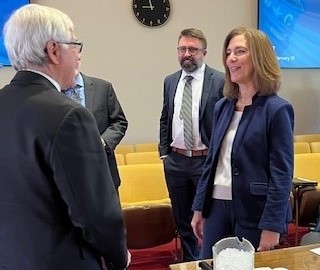
Members of the House Oversight and Reform Committee gained a clearer understanding of the North Carolina Reinsurance Facility Tuesday, January 30.
Executive Director Joanna Biliouris explained that the Facility exists because drivers are required to purchase liability insurance, insurers cannot set rates entirely based on the risk of a specific policy, and the rates that are allowed are too low for companies to provide that insurance to everyone. In short, the Facility does what it was created by statute to do. but that the Facility can’t quantify its own value. Legislators also learned that the Facility operates as it does due to how the insurance commissioner sets auto liability rates.
The cost of the Facility in the year ending June 30,2023, was $360 million in surcharges on every auto liability policy written in North Carolina, but the value is harder to quantify. Biliouris said, “The Facility cannot be credited with North Carolina having such low liability rates, but North Carolina’s low liability rates can be attributed to the Facility being a part of the state’s regulatory and statutory landscape.”
Ads tout that customers can purchase insurance priced to their driving habits. However, in North Carolina that is not the case: all drivers pay 9.8% higher premiums through a surcharge to cover riskier drivers in the Reinsurance Facility. Biliouris told the committee that the Facility covers 28% of premiums and 20% of policies. Even policies in the Facility pay the surcharge, which means many of them could be cheaper if an increase in premiums led to a larger reduction in the surcharge.
Fully 78% of vehicles in the Reinsurance Facility are “clean risks,” meaning the associated drivers have no points on their driving record but have other factors, such as speeding tickets, accidents, or inexperience behind the wheel that make them more likely have a claim.
Legislators focused on ways to improve the broader market and reduce the need for the Reinsurance Facility.
“I’m hoping we can do some things to accelerate this transition
Rep. Jake Johnson
and get it moving faster.”
Representative George Cleveland (R-Onslow) asked, “Can the Facility do its function as provided by law if clean risks were not allowed?”
“If there was more flexibility in the rates that companies could charge [in the voluntary market], they would likely not send that risk to the Facility.” Biliouris acknowledged. “If the Facility was able to determine the rates for any risk that came in,” it could. Such changes could result in lower premiums and surcharges for most drivers.
“I see a recurring problem, and that is that I believe insurance rates are insufficient,” Rep. Allen Chesser (R-Nash) said. “Is it a bigger problem that inadequate rates have been approved?”
“The drivers that are ceded to the Facility are primarily ceded because it was too much risk for the company to take on for not enough price,” Biliouris said.
Biliouris agreed with co-chair Harry Warren (R-Rowan), “If rates were raised…there would be a reduction in the number of policies ceded.”
Co-chair Rep. Jake Johnson (R-Polk) concluded that he saw a need for reform: “I’m hoping we can do some things to accelerate this transition and get it moving faster.”